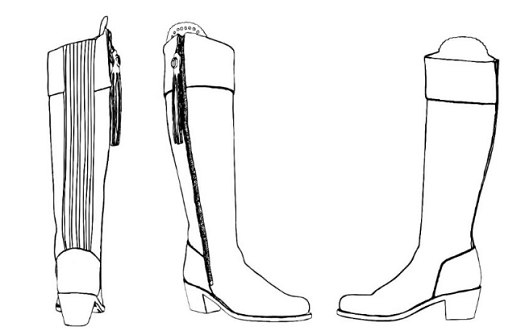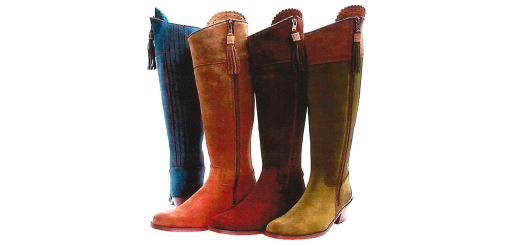Press Coverage - 30/06/2022
Fairfax & Favor outboot Bruar

Claire Lehr and Lara Persell recently wrote an article for the World Trademark Review (WTR) analysing the Intellectual Property Enterprise Court’s decision on a Registered Community Design and UK Unregistered Design Rights dispute concerning luxury women boots.
- Fairfax & Favor filed suit against Bruar, alleging infringement of its RCD and UKUDR in the ‘Heeled Regina’ boot
- The recorder found “with no hesitation” that all versions of the defendant’s boots had deliberately copied the claimant’s designs
- Two versions of the defendant’s boots infringed the RCD, while a third one did not
The Intellectual Property Enterprise Court has found a Registered Community Design (RCD) for a ladies’ boot valid and infringed by two boot products, but not the third, as well as finding UK Unregistered Design Rights (UKUDR) to subsist in a boot design (Fairfax & Favor Ltd v The House of Bruar Ltd ([2022] EWHC 689 (IPEC)).
Background
The claimant, Fairfax & Favor, is a luxury leather brand. The defendant, The House of Bruar, is a Scottish company which sells traditional attire from a number of well-known brands. The case concerned the design of the claimant’s ‘Heeled Regina’ boot. The Heeled Regina boot featured an “elasticated gusset”. There was a demonstrable evolution of the boot from its early versions in around 2013 to the Heeled Regina.
In 2015 the claimant commenced discussions with the defendant to supply them with boots – which did not lead to sales of boots. However, during the course of discussions, the claimant sent the defendant’s buyer (Mrs Meikle) a brochure which included the Heeled Regina.
In January 2016 the claimant filed the following RCD application:

Further discussions between the parties took place in 2017, which again did not lead to sales. In April 2017 Mrs Meikle purchased a pair of Heeled Regina boots, apparently for her own use. Around a month later, a further purchase of Heeled Regina boots, in a different colour, was made on the defendant’s company credit card.
In the meantime, the defendant ordered samples and stock of Version 1 boots (‘V1’) through another company, but experienced supply problems.

The defendant’s catalogue of 2017/2018 included V1 boots. The claimant, minded to send a letter of complaint, held off from doing so when Mrs Meikle placed a single, small order.
The case
The defendant’s 2018/2019 catalogue also included V1 boots. The claimant sent a letter of complaint to the defendant in August 2018. The defendant made “minor modifications” to the boots, creating Version 2 (‘V2’) and Version 3 (‘V3’) to “differentiate” its product from the claimant’s.
The claimant relied on its RCD as well as UKUDR, the partial designs being set out below:

The defendant claimed that the “elasticated gusset” was commonplace.
Decision
UKUDR
The claimant relied on seven features of the Heeled Regina:
- the mid-height heel;
- the height of shaft;
- the narrowing of the boot above the ankle;
- the narrow shape of the toe;
- the panelled gusset;
- the sloping cuff at the top of the boot; and
- the decorative features.
“With no hesitation”, Miss Recorder Amanda Michaels found all versions of the defendant’s boots had deliberately copied the claimant’s designs, noting that the “denial of copying” was “… incompatible with… documentary evidence”, as the defendant had had sight of the boot.
The recorder also found that the defendant’s V1 and V2 boots were infringing of the partial designs. V1 looked identical to the Heeled Regina at first glance, although there were some minor differences (including the narrow piping around the top and the fact the front of the boot is made in two pieces not one). V2 was also “extremely similar to the Heeled Regina”.
There were some differences with the V3 boots and, while V3 was not made exactly or substantially to the design of the Heeled Regina, it nonetheless infringed the claimant’s UKUDR.
The claimant was also successful in its claim for secondary infringement, satisfying the burden of proving that the defendant had sufficient knowledge that their boots were infringing articles, on the basis of the brochure sent over, and the employee purchases of the Heeled Regina.
RCD
The different test for infringement of an RCD brought minor relief to the defendant with the recorder holding that the V1 and V2 boots infringed the RCD, whereas V3 did not. Although V3 was closer to the RCD than V1 and V2, especially at the front of the boot, the presence of leather strips over elasticated panels at the back of the boot created a different overall impression to the RCD.
Comment
This decision has raised some interest, largely because the claimant was successful in both its claims in RCD and UKUDR.
Evidence was crucial and here the defendant was on the back foot. It amended its defence to rely on a boot which, the recorder noted, was only discovered “after a lengthy and thorough research process undertaken by their solicitors”. The boot could not be said to be “commonplace” and, while it did not materially affect the recorder’s findings, the amendment did nothing to support the defendant’s case. That, together with documentary evidence contradicting the oral denials of copying by witnesses for the defendant, contributed to the claimant’s resounding victory.
This article first appeared in WTR Daily, part of World Trademark Review, in May 2022. For further information, please go to www.worldtrademarkreview.com.













